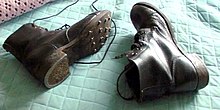Hobnail: Difference between revisions
m Reverted edits by 128.9.208.199 (talk) to last version by 123.2.48.45 |
No edit summary |
||
| Line 10: | Line 10: | ||
Important design work for the modern hobnailed boot was done during [[World War I]], e.g. the "Pershing Boot" in the USA.<ref>{{cite web|url=http://www.worldwar1.com/dbc/l_tanks.htm |title=Little Tanks - The American Field Shoe [Boot] |publisher=Worldwar1.com |date=1918-11-11 |accessdate=2009-09-06}}</ref> |
Important design work for the modern hobnailed boot was done during [[World War I]], e.g. the "Pershing Boot" in the USA.<ref>{{cite web|url=http://www.worldwar1.com/dbc/l_tanks.htm |title=Little Tanks - The American Field Shoe [Boot] |publisher=Worldwar1.com |date=1918-11-11 |accessdate=2009-09-06}}</ref> |
||
Problems experienced in designing WWI USA army boots were: |
|||
*Tearing at the [[backstay]]: cured by sewing the backstay on with 3 rows of stitching each side. |
*Tearing at the [[backstay]]: cured by sewing the backstay on with 3 rows of stitching each side. |
||
*Letting water in: cured by [[dubbin]]. |
*Letting water in: cured by [[dubbin]]. |
||
Revision as of 07:00, 3 December 2012
- For other uses, see Hobnail (disambiguation).


In footwear, a hobnail is a short nail with a thick head used to increase the durability of boot soles.
Hobnailed boots (known in Scotland as "tackety boots") are boots with hobnails (nails inserted into the soles of the boots), usually installed in a regular pattern, over the sole. They also usually have an iron horseshoe-shaped insert, called a heel iron, to strengthen the heel, and an iron toe-piece. The hobnails project below the sole and provide traction on soft or rocky ground, ice, and snow, but they tend to slide on smooth hard surfaces.
They have been used since antiquity for inexpensive durable footwear, often by workmen and the military, including as the trench boots of World War I.
Important design work for the modern hobnailed boot was done during World War I, e.g. the "Pershing Boot" in the USA.[1] Problems experienced in designing WWI USA army boots were:
- Tearing at the backstay: cured by sewing the backstay on with 3 rows of stitching each side.
- Letting water in: cured by dubbin.
- Rotting in foul conditions in trenches: cured by chrome tanning rather than only using vegetable tanning.
- Cold conducting through the hobnails into the feet: that and need for strength was cured by three thicknesses of leather in the soles.
- Sole wear: toe and heel irons as well as hobnails.
Hobnailed boots gained particular notoriety during the Second World War as the standard footwear of German troops, which in conjunction with the distinctive goose-step march upon cobblestone streets, left a lasting impression of their martial entrance into countless towns and villages throughout Occupied Europe.
Etymology
- Hobnail: Chambers's etymological dictionary of the English language: [1]
- Stud: Chambers's etymological dictionary of the English language: [2]
References
- ^ "Little Tanks - The American Field Shoe [Boot]". Worldwar1.com. 1918-11-11. Retrieved 2009-09-06.
